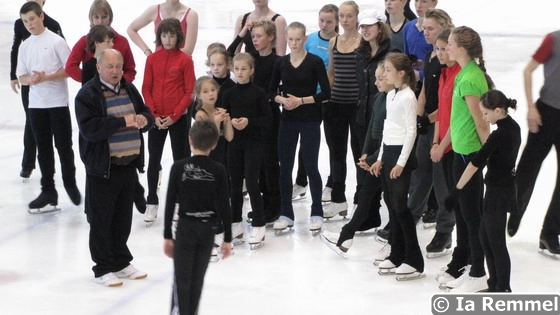The story behind success: MishinÂ’s and GachinskiÂ’s season preparation
November 4, 2011
By Ia Remmel
Photos © Ia Remmel, Mauro Binelli, Scanpix
 During the summer young figure skaters are often occupied with various training camps. They visit different training environments across the world instead of the ones they are used to.
During the summer young figure skaters are often occupied with various training camps. They visit different training environments across the world instead of the ones they are used to.
Alexei Mishin, one of the most famous figure skating coaches, picked Jaca in Spain, Tartu in Estonia and Pinzolo in Italy as training grounds for this summer. Professor Mishin believes that having a variety of different training locations has a positive effect on athletes as a change in the environment can give the skaters renewed drive and help them break out of their usual routine.
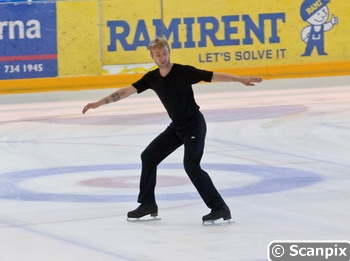 The session in Tartu took place from the 28th of June until the 10th of July. Tartu, a small university town by a river, provided the camp with a positive training environment and with quaint and peaceful atmosphere. The sessions took place in TartuÂ’s new ice rink that is located in a large shopping center. There were many children among the trainees, including both small children as well as MishinÂ’s star pupils Artur Gachinski and Liza Tuktamysheva. A talented young Estonian skater Sindra Kriisa was also at the camp. Evgeni Plushenko, one of the biggest stars who recently returned to competitive figure skating, has also trained at that rink.
The session in Tartu took place from the 28th of June until the 10th of July. Tartu, a small university town by a river, provided the camp with a positive training environment and with quaint and peaceful atmosphere. The sessions took place in TartuÂ’s new ice rink that is located in a large shopping center. There were many children among the trainees, including both small children as well as MishinÂ’s star pupils Artur Gachinski and Liza Tuktamysheva. A talented young Estonian skater Sindra Kriisa was also at the camp. Evgeni Plushenko, one of the biggest stars who recently returned to competitive figure skating, has also trained at that rink.
Just like in the last several years, the camp was organized by an Estonian Kersti Kull. She herself has long been involved in skating, with her daughter Sindra as an aspiring young figure skater. As to why Mishin chose Tartu as one of his training grounds, she said  that professor Mishin had always had good connections with Estonia, having competed here a long time ago and thus remembering many former Estonian figure skaters. According to her, another reason was TartuÂ’s new and comfortable ice arena, which Mishin found quite suitable. The final factor was TartuÂ’s close proximity to Russia, which meant that it was easier and less costly for the young skaters to get to the camp. Figure skating can be an expensive sport and a burden on the wallets of the parents of young figure skaters, so it is good to save money on training camps whenever possible.
that professor Mishin had always had good connections with Estonia, having competed here a long time ago and thus remembering many former Estonian figure skaters. According to her, another reason was TartuÂ’s new and comfortable ice arena, which Mishin found quite suitable. The final factor was TartuÂ’s close proximity to Russia, which meant that it was easier and less costly for the young skaters to get to the camp. Figure skating can be an expensive sport and a burden on the wallets of the parents of young figure skaters, so it is good to save money on training camps whenever possible.
Kersti Kull also shed some light on the training schedule. The skaters started at 8 oÂ’clock. After 30 minutes of warm-up and stretching they had a technical training panel guided by Mishin. After that they practiced jumps on the floor, guided by MishinÂ’s pupil Igor Novodran. According to Kersti Kull, Mishin has been known to emphasize the importance of this part of the training, having once claimed that pupils unable to jump on the floor will not be able to do that on the ice either.
After that it was time for a lunch break. During this part of the schedule the trainees rested from the often exhausting training sessions and some younger children even took naps. They started again at 3 p.m. with a combined training session focusing on basic step sequences and spins. Later the younger skaters would work on choreography and take ballet lessons. Finally, the training involved sessions at the gym, massages and swimming. Working with them this year were two choreographers – David Avdish, Plushenko’s choreographer, and Georgi Kovtun. In Jaca they also had a third choreographer – American Tom Dickson. In the third camp Pinzolo was joined by Stéphane Lambiel, who worked on choreography, step sequences, transitions and spins. Kersti Kull commends Lambiel for the inspiration he gave to the team, saying that he did a good job motivating the students and instructing them by using examples. Overall Kersti Kull praised the mood at the camp, saying that all the children and their parents were like a friendly family who provided each other support.

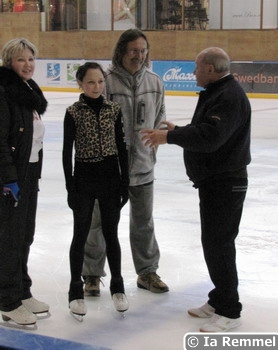
Kersti Kull also elaborated on the way that Mishin works. She said that Mishin prefers to base his training on his own experience but also science. He often works with his friend, scientist Alexander Shapiro. Mr. Shapiro measures the precision, the speed and the efficiency of the skatersÂ’ movements, looking for ways to help them improve. Mishin is also known to value team work and appreciate the people that he works with. Members of his team include his wife Tatyana Mishina, his former pupils Oleg Tataurov and Igor Novodran and also Svetlana Veretennikova, Svetlana Prokofjeva and Sergei Yugarov.
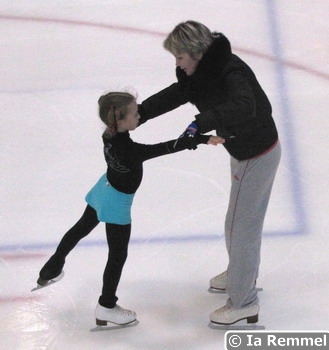
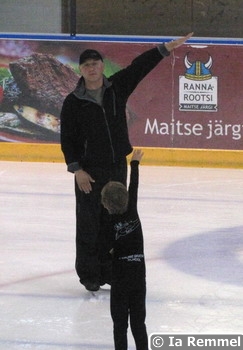
When it comes to the countries of origin of the skaters at the camp, Kersti Kull said that many children were from Russia but that in Jaca there were also young skaters from Belgium, Spain, Sweden, England, and Scotland, such as Ira Vannut and Jorik Hendrickx, Javier Fernandez, Javier Raya and Sonia Lafuente, Alexander Majorov, Harry Mattick and many others.
Estonian
hope Sindra Kriisa has already attended MishinÂ’s camps before. She said
that it is always a great opportunity to take part in such a camp and work
with a great coach like Mishin. According to her, the atmosphere is always
positive at the camp, with Mishin being a friendly, calm and good-humored
coach; although, he can also be strict when necessary. Sindra Kriisa started
out as a rhythmic gymnast but became involved in figure skating through
her mother. Even though she now focuses on figure skating, she still uses
some elements from rhythmic gymnastics in her exhibition number. Her great
model is Liza Tuktamysheva, who was also at MishinÂ’s camp; her other idols
include Carolina Kostner and Sarah Meier. Her coach is Sanna Remes from
Finland who has been based in Tartu for some time now. SindraÂ’s current
programs are choreographed by Georgi Kovtun and Tom Dickson, including a
short program with tango elements and a free program to Spanish music. Her
aim for the new season is to do well in the Junior Grand Prix series and
at the Estonian Championships. Her goals after that depend on her results
at the Estonian Championships.
 18-year-old Russian Artur Gachinski is one of professor Mishin’s star pupils. He has set clear aims for his career and is totally concentrated during his training session, letting nothing distract him. However, this doesn’t prevent him from joking around and being a normal 18-year-old guy. His hobbies are reading, music and video games. However, due to his dedication to figure skating, he doesn’t have much leisure time. His mother is a painter – perhaps this type of drive originates from her and has influenced him to become deeply involved in figure skating, which is closely connected with art.
18-year-old Russian Artur Gachinski is one of professor Mishin’s star pupils. He has set clear aims for his career and is totally concentrated during his training session, letting nothing distract him. However, this doesn’t prevent him from joking around and being a normal 18-year-old guy. His hobbies are reading, music and video games. However, due to his dedication to figure skating, he doesn’t have much leisure time. His mother is a painter – perhaps this type of drive originates from her and has influenced him to become deeply involved in figure skating, which is closely connected with art.
Many say that he might be the “next Plushenko”. He takes this calmly, saying that although they train with the same coach, they are different skaters with a different style.
What was the secret of your successful season?
No secrets. I just worked hard with my coach Alexei Nikolaevich Mishin. I had very good and suitable programs with good music choices, especially my long program to ShostakovitchÂ’s music from the ballet Bolt.
Expectations of you are very high now. How do you plan your future development?
I have to work thoroughly on all elements: step sequences, spins, transitions. I want to add new jumps to my arsenal. Right now we are working on quad Salchow and quad loop.
How do they come off?
Quite successfully so far. I do them regularly in practice.
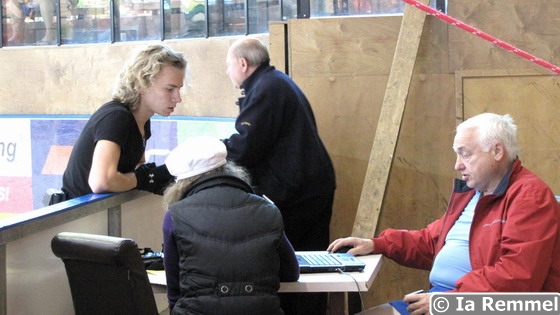
It is generally known that there are many skaters who are able to perform rare quad jumps like the Salchow, the loop or the Lutz in practice but during competitions we seldom see quad jumps other than the toe loop. How do you hope to succeed with the new quads in competitions?
We see these so rarely because in the competition skaters experience severe stress and high responsibility. These quad jumps are very risky and you lose valuable points if you fail. ThatÂ’s why people rarely try them and use safer elements.
Who choreographed your programs for the new season?
My current programs are choreographed by an American choreographer Tom Dickson and a Russian choreographer Georgi Kovtun.
What music have you chosen for your programs?
My short will be to jazz music and I havený chosen any motif for it yet. My long program is to the music from Interview with the Vampire and Bram Stoker's Dracula. The choreography is difficult but the motifs of the program inspire me a lot. [He portrays a demon who has been stranded on Earth. During his tribulations he meets a girl and falls in love with her. He is faced with the inner struggle of taking the girl with him or die – and in the end he chooses to die. - ed]
The ideas for both programs came from Tom Dickson. They are a work in progress; there will be changes in the order of elements.
This isnÂ’t your first time working with Dickson, is it?
No, he also choreographed my short programs a couple of years ago.
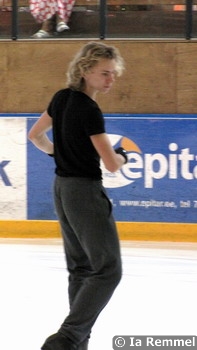 Alexei Mishin is one of the best and most famous coaches in the world. How does he help you when problems arise with technical elements?
Alexei Mishin is one of the best and most famous coaches in the world. How does he help you when problems arise with technical elements?
He always keeps calm and calms me down, shows me what I am doing wrong. Sometimes he analyzes my jumps on the video. We watch them together and he shows me where I made mistakes.
Figure skating is a sport where there are a lot of psychological factors. How does your coach help you psychologically?
He just explains to me that there is nothing to fear. If you have done your job properly, you know what to do and you just have to go on the ice and realize it.
I read in some of your previous interviews that you are especially calm and never panic. How do you manage to do that?
ThatÂ’s just the way I am. I keep a calm attitude in every competition and try not to panic.
How did you get involved in figure skating? Was it yours or your parentsÂ’ decision?
I was six years old when my parents brought me to an ice rink. I enjoyed skating then and enjoy it now.
Who among the skaters has been your idol and inspired you?
That has always been Evgeni Plushenko.
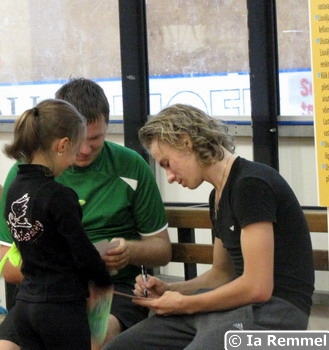 Do you remember the moment when you first showed your skating skills to Mishin? Was it an anxious moment?
Do you remember the moment when you first showed your skating skills to Mishin? Was it an anxious moment?
I donÂ’t remember being very anxious. Alexei Nikolaevich talked with my parents and apparently he saw some potential in me since he accepted me as his pupil. During the first few years I trained with his wife Tatyana Nikolajevna, later on he started to coach me himself.
In your opinion, how does PlushenkoÂ’s comeback influence the figure skating world?
Hard to say, we have to see how he does in competitions.
When it comes to your opponents, current world champion Patrick Chan seems to be invincible at the momentÂ…
No one is invincible, everyone can be beaten. He is very good - so to beat him, you have to become better. You have to work very hard, improve all the elements. Hard work is the key.
His skating significantly improved during his cooperation with Stéphane Lambiel [in preparation for the season] where they worked with Gachinski's sliding and spins. Stéphane also gave advice in choreography and movements.
Gachinski is now facing his first Grand Prix competition, the Cup
of China. He has already competed at the Japan Open, also with Patrick Chan
where his score was 152,71 versus ChanÂ’s 159,93. It seems GachinskiÂ’s hard
work has paid off.
